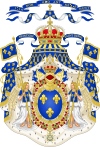Philippe Charles, Duke of Anjou
| Philippe Charles | |
|---|---|
| Duke of Anjou | |
 Mythological portrait of Louis XIV and the royal family, by Jean Nocret | |
| Born | 5 August 1667 Château de Saint-Germain-en-Laye |
| Died | 10 July 1671 Château de Saint-Germain-en-Laye |
| Burial | 12 July 1671 |
| House | Bourbon |
| Father | Louis XIV |
| Mother | Maria Theresa of Spain |
Philippe-Charles, Duke of Anjou (5 August 1667 – 10 July 1671) was the fifth child and second son of King Louis XIV of France and Maria Theresa of Spain, and as such was a fils de France.
Life[edit]
Philippe-Charles de France was born at the Château de Saint-Germain-en-Laye, near Paris, and titled duc d'Anjou at birth, a title previously held by Philippe de France, duc d'Orléans, his uncle and the younger brother of Louis XIV. He was baptised at the Chapelle des Tuileries à Paris on 24 March 1668.[1][2]
As a younger son of Louis XIV, Philippe-Charles was not expected to become the Dauphin; however, it was hoped he would inherit the vast fortune of his second cousin, Anne Marie Louise d'Orléans, Duchess of Montpensier, who had no children. According to Nancy Mitford, the Queen, his mother, suggested it many times. While at Saint-Germain-en-Laye, Philippe-Charles died of a chest infection,[a] like his elder sister, Anne-Élisabeth de France who had died six years before his birth. Upon his death, the appanage of the Duchy of Anjou reverted to the Crown and was given to his younger brother, Louis François. Philippe-Charles was buried on 12 July 1671, at the Basilica of Saint-Denis.[1]
At the death of the Duchess of Montpensier in 1693, her fortune went to her direct and legal heir, the House of Orléans (Philippe's uncle Philippe I, Duke of Orléans).
Ancestry[edit]
Footnotes[edit]
- ^ With the limitations of 17th Century medicine, "chest infection" cannot be identified precisely.
References[edit]
- ^ a b "Philippe de Bourbon". Roglo.eu. Retrieved January 4, 2012.[self-published source]
- ^ Musée des Archives nationales: documents originaux de l'histoire de France exposés dans l'Hotel Soubise : ouvrage enrichi de 1,200 fac-simile des autographes les plus importants depuis l'époque mérovingienne jusqu'a la révolution française (in French). Interstate Board of the Perry's Victory Centennial Commissioners. 1872. p. 511. Retrieved 21 September 2023.
- ^ a b c d e f g h i j Anselm de Guibours (1726). Histoire généalogique et chronologique de la maison royale de France [Genealogical and chronological history of the royal house of France] (in French). Vol. 1 (3rd ed.). Paris: La compagnie des libraires.
- ^ a b Wurzbach, Constantin von, ed. (1860). . Biographisches Lexikon des Kaiserthums Oesterreich [Biographical Encyclopedia of the Austrian Empire] (in German). Vol. 6. p. 152 – via Wikisource.
- ^ a b Chisholm, Hugh, ed. (1911). . Encyclopædia Britannica. Vol. 21 (11th ed.). Cambridge University Press.
- ^ a b Leonie Frieda (14 March 2006). Catherine de Medici: Renaissance Queen of France. HarperCollins. p. 386. ISBN 978-0-06-074493-9. Retrieved 21 February 2011.
- ^ a b Chisholm, Hugh, ed. (1911). . Encyclopædia Britannica. Vol. 21 (11th ed.). Cambridge University Press.
- ^ a b Wurzbach, Constantin von, ed. (1861). . Biographisches Lexikon des Kaiserthums Oesterreich [Biographical Encyclopedia of the Austrian Empire] (in German). Vol. 7. p. 13 – via Wikisource.


